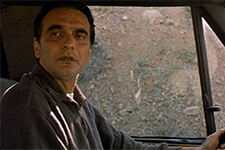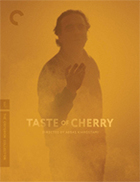Taste of Cherry (Ta’m e guilass)
|  Abbas Kiarostami’s Taste of Cherry (Ta’m e guilass), the first Iranian film to share the coveted Palm d’Or at the Cannes Film Festival (it tied with Shohei Imamura’s The Eel), is a curious film. On the one hand, it is quite literal in its stark, unadorned depiction of a man driving around the outskirts of Tehran in an attempt to find someone who will be willing to bury him after he commits suicide. On the other hand, the film is so lacking in specifics, so devoid of character detail or background or context, that it is hard to take it literally. It is both drama and allegory, and while it has been met with ardent praise from critics over the years, it doesn’t quite work for me either way. Homayoun Ershadi, who had previously worked as an architect before Kiarostami cast him, plays a man named Mr. Badii, who we first meet inside his Range Rover as he drives through the streets of Tehran, looking intensely out the window at the people on the streets. He eventually makes his way into the less populated areas in the scorched hills just outside the city, where he meets some children and a construction worker who assumes he is cruising him and threatens to beat him up. At this point, we have no idea what Mr. Badii is looking for, but he is clearly looking for something. We eventually learn his aims after he picks up a soldier (Safar Ali Moradi) who is on his way back to the barracks. The soldier is young—still a teenager with acne and an insecure air about him—and he is clearly uncomfortable riding with Mr. Badii and the series of questions he is asked, not to mention the excessively long and out-of-the-way route Mr. Badii takes, all the while promising him that he will get him back to the barracks on time. He finally stops on a remote hillside by a tree, next to which is a hole in the ground. Mr. Badii informs the soldier that he will pay him a great deal of money—half his annual wages—if he will return to the hole at 6:00 a.m. the next morning and call his name twice. If he replies, the soldier is to help him out of the hole. If he doesn’t, he is to shovel 20 spadefuls of dirt on top of him and leave. The soldier runs away. Kiarostami repeats this basic set-up two more times, as Mr. Badii picks up a young seminary student (Mir Hossein Noori) and then a taxidermist who teaches at a university (Abdolrahman Bagheri). The seminarian, who is also very young, refuses on religious grounds, since suicide is strictly forbidden by the Quran, but the taxidermist, an old man who once attempted suicide himself, agrees to the deal, although reluctantly and not without trying to convince Mr. Badii to do otherwise by relating his own story in which his suicide was thwarted by his discovery of delicious mulberries on the tree on which he intended to hang himself. Mr. Badii also briefly speaks with a man who is guarding a deserted construction site (Afshin Khorshid Bakhtiari), but otherwise there are no other interactions or incidents. Kiarostami keeps the story simple and straightforward, although some of his narrative choices create temporary confusion, such as his decision to leave out how and where Mr. Badii meets the taxidermist. The character is introduced suddenly as a voice on the soundtrack heard over long shots of Mr. Badii’s Range Rover, and the first cut into the car is to Mr. Badii, rather than the taxidermist, which gives the prolonged impression that the voice is somehow in Mr. Badii’s head. Given the simplicity of the plot and its general lack of urgency, despite being driven by the classical Hollywood strategy of the goal-oriented protagonist, it would be foolish to view Taste of Cherry in purely literal terms. Almost everything about it begs for some kind of allegorical or symbolic or socio-cultural reading, from the distinctly varied ethnicities of the men Mr. Badii picks up (the soldier is a Kurd, the seminarian is an Afghani, and the taxidermist is a Turk), to the emptiness of Mr. Badii himself, about whom we learn virtually nothing, including his reasoning for wanting to kill himself. Of course, such explanations are largely beside the point, as his death wish matters only in and of itself. Kiarostami is after grand truths about human existence, the kind that don’t get bogged down in specific details. He is making a film about capital-L Life and capital-D Death, and any explanation of Mr. Badii’s suicidal ideation would simply make it banal. Or would it? This is where I struggle with Taste of Cherry because its philosophical ruminations don’t strike me as all that deep, certainly not profound enough to support its narrative elusiveness and ambiguity. Maybe Mr. Badii’s plight would take on more philosophical depth if I had some understanding of who he is, rather than just him as Man Who Wants to Die. It is also notable that the film is not strictly philosophical in all its narrative strands. While Mr. Badii’s discussions with the seminarian and the taxidermist rely heavily on theology and personal conviction about the nature of life and death, his conversation with the soldier is purely functional, working to reveal Mr. Badii’s true intentions while dramatizing the young man’s discomfort with the situation in which he finds himself. No greater truths are revealed other than the fact the soldier is freaked out and wants to get the hell out of there (which provides the film its one moment that could be considered humorous). From a technical standpoint, Taste of Cherry is impressive in its focused simplicity. The vast majority of the shots are either shot-reverse-shot close-ups and medium close-ups of the characters in the Range Rover (we never see them in the same shot together) or extreme long shots of the car driving up and down dirt paths cut into the hillsides outside Tehran. The cinematography by Homayun Payvar (who had previously shot Kiarostami’s And Life Goes On) emphasizes the arid nature of the land, with its orange-brown expanses of dirt and sparse, yellow vegetation, which makes it all the more notable when we see a blooming tree. The actors, all of whom are nonprofessionals, are convincing and at times moving. The taxidermist, despite the relatively facile nature of his argument in defense of life, is entirely convincing in his belief, which is really the point. The idea that the delightful taste of cherry is enough to thwart one’s deep desire to leave this world is naïve at best, but it is a core conviction of this man and therefore has poignancy. It is also worth noting the film’s controversial ending. After we see shots of Mr. Badii lying in his dark grave, possibly dead, we are unexpectedly taken out of the film’s diegesis into low-resolution video of the film in production scored to Louis Armstrong’s “St. James Infirmary” (the film’s first and only use of nondiegetic music), which Kiarostami has said he used because he had heard it employed during both happy occasions and funerals, thus merging the film’s inherent sadness with his insistence that life continues despite a single individual’s death. We see see the actors out of character, Kiarostami directing, and cameramen setting up their equipment on the hillside. If you hadn’t seen any of Kiarostami’s previous films, this might strike you as a sudden and radical departure from the self-enclosed world of the story that had been created over the previous 90 minutes; but, if you have seen his previous meta-cinematic ruminations like And Life Goes On (1992) and Through the Olive Trees (1994), you will immediately recognize it as a continuance of Kiarostami’s fascination with revealing the mechanisms by which his films are made. Some have argued that this epilogue adds a sense of hope to a film that otherwise ends in despair, but I’m not sure it’s that simple since the film’s narrative ending is ambiguous (ambiguous endings being another of Kiarostami’s regular effects). I think Mr. Badii is dead, but there isn’t absolute proof. Is there still a flicker of life in his eyes, or is that just the lightning reflected in dead tissue? I don’t know for sure, and that is exactly what Kiarostami wants.
Copyright © 2020 James Kendrick Thoughts? E-mail James Kendrick All images copyright © The Criterion Collection | |||||||||||||||||||||||||||||||
Overall Rating: 

 (2.5)
(2.5)


